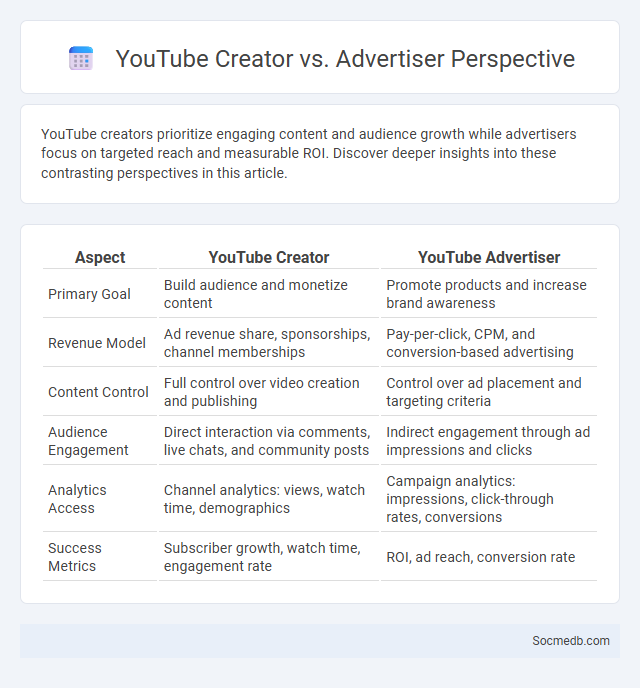
Photo illustration: YouTube Creator vs Advertiser Perspective
YouTube creators prioritize engaging content and audience growth while advertisers focus on targeted reach and measurable ROI. Discover deeper insights into these contrasting perspectives in this article.
Table of Comparison
| Aspect | YouTube Creator | YouTube Advertiser |
|---|---|---|
| Primary Goal | Build audience and monetize content | Promote products and increase brand awareness |
| Revenue Model | Ad revenue share, sponsorships, channel memberships | Pay-per-click, CPM, and conversion-based advertising |
| Content Control | Full control over video creation and publishing | Control over ad placement and targeting criteria |
| Audience Engagement | Direct interaction via comments, live chats, and community posts | Indirect engagement through ad impressions and clicks |
| Analytics Access | Channel analytics: views, watch time, demographics | Campaign analytics: impressions, click-through rates, conversions |
| Success Metrics | Subscriber growth, watch time, engagement rate | ROI, ad reach, conversion rate |
Understanding the YouTube Ecosystem: Creators vs Advertisers
The YouTube ecosystem thrives on the dynamic relationship between creators and advertisers, where creators produce diverse content that attracts millions of subscribers, fueling viewer engagement and platform growth. Advertisers leverage targeted ads to reach specific demographics, capitalizing on creators' niche audiences to enhance brand visibility and conversion rates. Balancing monetization interests with content authenticity remains pivotal in sustaining this symbiotic model within YouTube's vast digital landscape.
Monetization Strategies: What Drives Creators and Advertisers
Monetization strategies on social media platforms primarily revolve around content creation, influencer partnerships, and targeted advertising, generating substantial revenue streams for both creators and advertisers. Your ability to leverage sponsored posts, affiliate marketing, and subscription models can significantly enhance income potential while driving audience engagement. Data-driven insights and algorithmic targeting empower advertisers to optimize campaigns, ensuring maximum return on investment and sustained growth within competitive digital ecosystems.
Algorithm Changes: Impacts on Creators and Ad Revenue
Algorithm changes on social media platforms significantly affect content creators by altering visibility and engagement rates, often resulting in fluctuating ad revenue streams. Modifications to ranking criteria prioritize personalized content, which can disadvantage creators relying on broad audience reach or specific niches. Advertisers respond to these shifts by reallocating budgets toward platforms demonstrating higher user interaction, creating a dynamic landscape for monetization strategies.
Content Moderation: Navigating Brand Safety Concerns
Content moderation plays a crucial role in navigating brand safety concerns on social media platforms, ensuring that your brand is protected from inappropriate or harmful user-generated content. Employing advanced AI tools combined with human reviewers helps detect and remove offensive material, minimizing risks to your brand's reputation. Effective moderation strategies prioritize transparency and compliance with platform policies to maintain a safe and positive online environment for your audience.
Demonetization: Causes and Consequences for Creators
Demonetization on social media platforms occurs when creators lose access to revenue-generating features due to algorithm changes or policy violations. This sudden loss of income can significantly impact your ability to sustain content production and affect audience engagement. Understanding the causes, such as copyright issues or inappropriate content, enables creators to adapt strategies and mitigate negative consequences.
Advertisers’ Demands: Brand Control and Platform Expectations
Advertisers demand precise brand control to ensure messaging aligns consistently with their identity and values across social media channels. Platform expectations include adhering to content guidelines, utilizing advanced targeting algorithms, and leveraging analytics tools to optimize ad performance effectively. Your campaigns benefit from balancing stringent brand oversight with platform-specific requirements to maximize reach and engagement.
Creator Perspective: Freedom of Expression vs Platform Policies
Creators on social media navigate the complex balance between freedom of expression and strict platform policies that regulate content to ensure community safety and compliance with legal standards. Algorithmic moderation and automated content filters often challenge creators' ability to share nuanced or controversial topics without risking removal or shadow banning. Understanding platform-specific guidelines and leveraging platform appeals processes are crucial strategies for creators to protect their voice while adhering to evolving content standards.
The Role of Community Guidelines in Content Approval
Community guidelines are essential in regulating the type of content allowed on social media platforms, ensuring compliance with legal standards and protecting users from harmful material. These rules enable automated systems and human moderators to efficiently review and approve content, maintaining a safe and respectful environment for Your interactions. Clear guidelines foster trust among users by promoting transparency and consistency in content approval processes.
Economic Implications: Revenue Loss for Creators vs Advertisers
Social media platforms significantly impact economic dynamics by creating revenue opportunities for both creators and advertisers, yet they also face challenges with revenue loss due to ad-blocking and content monetization changes. Your earnings as a creator can decline when advertisers reduce spending due to ineffective targeting or shifts in platform algorithms. Advertisers experience revenue loss when user engagement drops or when platform policies restrict ad visibility, disrupting the balance of content monetization and advertising effectiveness.
Bridging the Gap: Finding Common Ground on YouTube
YouTube serves as a powerful platform for bridging social divides by enabling diverse communities to share their perspectives and foster mutual understanding. Content creators often use storytelling and collaborative projects to highlight shared values, helping reduce polarization and build empathy across differing viewpoints. This approach leverages YouTube's extensive reach and algorithmic recommendations to connect users with balanced, relatable content that promotes constructive dialogue.
 socmedb.com
socmedb.com